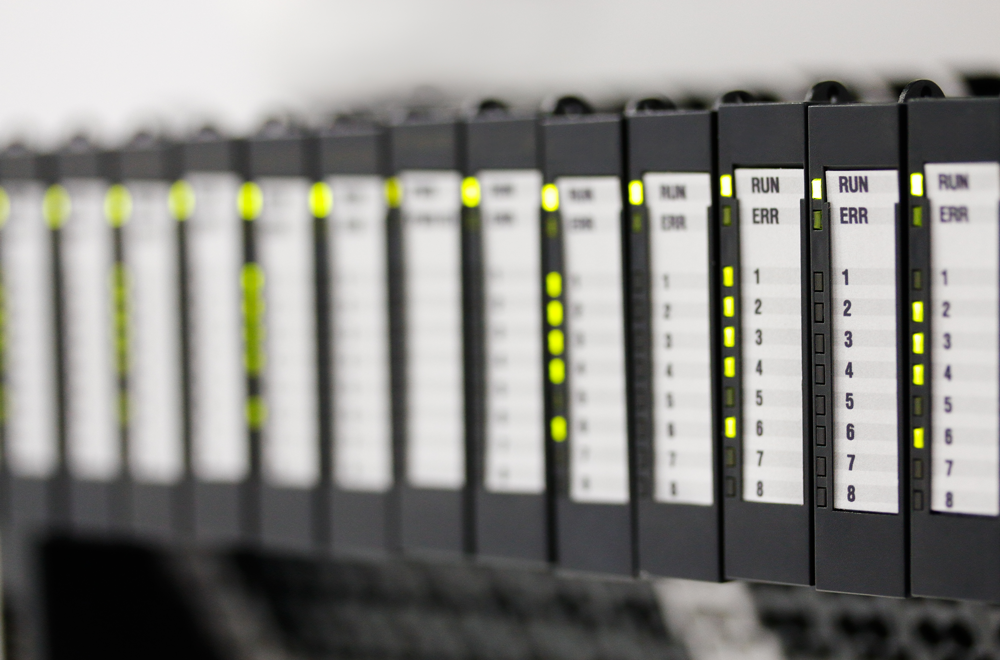A Power Plant Controller (PPC) is used to control and regulate the networked inverters, devices and equipment at a solar PV plant in order to:
- Meet specified setpoints and change grid parameters at the point of interconnect (POI) by regulating voltage, frequency, reactive power, active power, power factor and ramp control
- Control plant behavior in terms of grid stability, compliance, production levels and revenue
- Perform remote starts/stops or other troubleshooting actions on trackers, inverters, breakers and other field and substation equipment
There are two main types of PPCs: PC-based and hardware-based. You can learn more about the difference between them here. In this article we will focus on PLCs, which are a type of hardware-based PPC.
What is a PLC?
A Programmable Logic Controller (PLC) is a dedicated piece of hardware that controls devices or processes based on pre-programmed, closed-loop logic. PLC programming is the process of programming or writing the logic that the controller will follow in order to control its connected devices. The logic, or PLC program, is stored inside the hardware using non-volatile flash memory, a battery backed-up RAM, or a special chip. The PLC can then run the embedded logic on its own without the need for an outside computer and operating system (OS) like Windows.
What are some of the most commonly used and recommended PLC manufacturers and models for solar PV projects?
The PLCs we use and recommend most often are GE RX3i controllers, Emerson Ovation controllers and Allen-Bradley ControlLogix controllers. Allen-Bradley is also known as Rockwell Automation. These are slot-based hardware PLCs that can communicate with field or substation devices and equipment via several network protocols. They are open architecture, which means they are not limited to a proprietary SCADA platform or specific devices and equipment.
While not strictly PLCs, RTACs by Schweitzer Engineering Laboratories (SEL) can be used to perform the same or similar functions. RTAC stands for Real Time Automation Controller. SEL RTACs are powerful multipurpose controller/communication devices that can fulfill many roles at a solar PV plant. They are able to run and execute logic for nearly any application, sending out commands to control plant devices and regulating output.
However, RTACs do have some limitations in terms of advanced control capabilities. We typically recommend using a dedicated hardware PLC like the GE, Ovation or Allen-Bradley when an RTAC doesn't completely fill the advanced control requirements, or when you need extremely fast response control.
You can learn more about SEL RTACs here.
All of these controllers are industrially hardened to withstand rugged conditions like a substation or outdoor SCADA rack.
What are the main features of a PLC? What does a PLC usually include (hardware/software) and what options are available?
Most PLCs are module-based, meaning that they have a base with slots that the different modules fit into. The main module is the controller module, where the logic runs to and from. There is also a power supply module. From there, PLCs can have additional modules for serial communication, ethernet communication, and other types of hardwired I/Os. Some PLCs have these modules built in, while others have the option to add on modules depending on the kinds of connections you need. It all depends on the specific OEM and model you choose.
Most PLCs have software that you either have to buy separately or that comes with the controller purchase. This software is used to develop, configure or edit the logic that will go in the PLC. There aren't many different options; you typically buy the software that goes with your PLC.
What should you consider when choosing a PLC design/setup for a renewable energy project (solar and/or storage)?
The main consideration is processing capability, which will determine how many devices your PLC can communicate with successfully. You can run into problems with response time if you overload your PLC with more devices than it can handle and more data tags than it can support. This is not unlike trying to run a software program on a PC that doesn't quite have enough processing power and RAM.
You also need to consider how your devices will connect to and communicate with the PLC. Will they need to connect via serial connection or ethernet? Will they communicate via Modbus or DNP3 protocol? Depending on these options, you can pick different modules for your PLC or upgrade with hardware add-ons.
Cost is also a consideration. The larger the site and the more devices there are, the more processing power and physical connections the PLC will need, which will increase the cost. For some smaller sites, it may make financial sense to go with a non-PLC setup, like the SEL RTAC discussed earlier. At Nor-Cal we do not typically recommend PC-based controllers, but they can work on some smaller sites where cost is a major concern, as PC-based controllers are less expensive.
What drives the price of PLCs (hardware/software)?
The hardware drives the price. Just as PCs with more processing power cost more, so too do PLCs. The more processing power you need, the more expensive the PLC—and the amount of processing power you need ties back to how many devices the PLC needs to communicate with and control. The type and number of connection modules will also affect the price.
There's a base cost for the PLC software; it doesn't change. It's either a separate purchase or it may be available to download at no additional cost after you purchase the controller.
What are the main benefits of hardware-based PLCs?
The two main benefits of hardware-based PLCs are response time and reliability. Dedicated hardware PLCs are able to react to the external plant and the grid within milliseconds. They are fast and robust. Barring a network or power outage, they are always online and doing their job due to their pre-programmed functioning. This is different from a PC-based controller, which may go down if its PC or server goes down or reboots. This can cause non-compliance issues with the PPA or IA.
What are the main drawbacks of hardware-based PLCs?
The main drawback is the initial cost, as they're very expensive. It is good to think of them as a long-term investment that will pay off over time, in terms of their reliability, performance, hassle-free operation, and ability to meet PPA and IA requirements.
If you do ever run into issues with a PLC that you can't resolve yourself, the secondary drawback is that you will almost always have to reach out to the OEM. This can be a good and a bad thing. The good thing is, the support is typically excellent. The bad thing is, if there's ever a time when the OEM isn't around anymore, you're not going to have that support. However, the PLC OEMs we recommend have been around for a long time (100+ years for Emerson and Allen-Bradley/Rockwell Automation), so you can reasonably expect them to still be there for you over the life of your plant.
Want to learn more about solar PV plant controls?
Now that you've learned the PLC basics, take the next step and discover how they do their job. Our article on Power Plant Controllers: Typical Requirements for PV Sites covers the controls used to regulate active and reactive power in order to meet power requirements and support a stable grid.
If you have any questions about how Nor-Cal can help with your PLC programming, SCADA commissioning or any other aspect of your solar PV plant controls, please schedule a call today.





